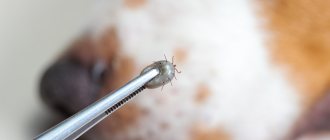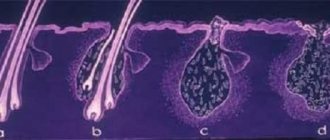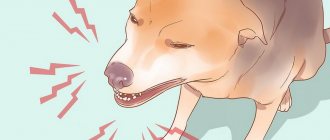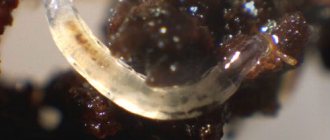Canine demodicosis is a parasitic skin disease caused by the proliferation of Demodex canis mites inside the hair follicle. The Demodex canis mite has an elongated lanceolate body, which is divided into a head, thorax and abdomen.
The head is equipped with a movable proboscis, has upper and lower jaws, and three-segmented tentacles on the upper jaw. The tick has four pairs of short, three-jointed legs. The dimensions of an adult tick are 220 - 300 microns long, 42 - 48 microns wide.
What to do in such a situation? To get started, we recommend reading this article. This article describes in detail methods of controlling parasites. We also recommend that you consult a specialist. Read the article >>>
Symptoms of demodicosis in animals
The symptoms of this disease vary from person to person. The main signs are rough skin, pimples, itching, hair loss, etc. This disease is considered contagious - parasites can pass from one dog to another. Different animal species have different causative agents of demodicosis. Cats have their own parasites, and dogs have theirs.
The prevalence of demodicosis lesions
According to the degree of prevalence of lesions, localized (local) demodicosis and generalized (general) demodicosis are distinguished.
Localized form of demodicosis:
- No more than 4 sites of skin lesions;
- Lesion diameter ≤ 2.5 cm;
- No entire body part or more than one paw is affected.
The prognosis for localized demodicosis is good as most lesions resolve spontaneously within 6-8 weeks. Local therapy using shampoo or gel is recommended.
Generalized form of demodicosis:
- More than 4 sites of skin lesions;
- Lesion diameter > 2.5 cm;
- At least one part of the body (for example, the muzzle) or more than one paw is affected.
The generalized form in young dogs is associated with a hereditary deficiency of cellular immunity to this mite; it is characterized by damage to a larger surface of the skin. The localized form usually does not require treatment.
Effective treatment of generalized demodicosis requires a multimodal approach. In order to give a prognosis and ensure successful treatment, it is very important to determine:
- Age of onset of disease;
- Size and location of skin lesions;
- Presence of secondary infections;
- General health of the dog.
Regardless of age, it is important to identify and treat any predisposing or contributing factors in order to achieve a successful outcome.
Symptoms and diagnosis
The external signs of demodicosis and scabies are very similar, and it is difficult to find out exactly what the dog is sick with without laboratory tests. The causative agent of the disease is identified by deep scraping the top layer of skin. General manifestations of scabies and demodicosis:
- incessant itching;
- skin redness;
- local baldness;
- unpleasant smell of wool;
- anemia (in advanced stages of the disease).
Treatment of demodicosis is a long process, and the animal is not considered healthy even two years after the onset of remission.
The disease is divided into two forms:
- Scaly (mild form). Round bald spots appear on the dog's face and paws, the skin turns red, becomes rough and cracks.
- Pustular. Yellowish, black or brown pustules (bumps) filled with pus form on the surface of the skin. When severely infected, pustules develop into ulcers. The skin becomes dense, moist, wrinkled, and emits an unpleasant putrid odor. The lesions are located on the ears, eyebrows, muzzle and paws.
Scabies mites are divided into two types. Depending on the pathogen, the following types of scabies develop:
- Classic - caused by sarcoptic mange, with symptoms similar to demodicosis, but with the formation of foci of inflammation already at the initial stage.
- Ear - the causative agent of notoedrosis. The outer part of the ear is affected and is accompanied by severe itching, which the dog tries to eliminate by shaking its head or scratching.
It is impossible to independently diagnose the disease and self-medicate, since the signs of subcutaneous mites in dogs are similar to the symptoms of various fungal and bacterial skin diseases. Therefore, if suspicious symptoms are detected, the dog is given an anti-allergy drug (suprastin) to relieve the itching and taken to a veterinary clinic. Neither demodicosis nor scabies are dangerous to humans, since human skin is parasitized by its own species of mites.
Forms of the disease
The first signs of the disease become noticeable when the demodex mite in dogs, against the background of active reproduction, creates large populations. Pathology can occur in different ways, so there are several forms:
- focal (local);
- pustular;
- generalized.
Juvenile demodicosis in dogs is diagnosed when the animal is not yet 1 year old.
Focal
The mildest form of pathology is considered to be focal or scaly demodicosis. In sick dogs, 3 to 5 small flaky areas of skin without hair are visualized, having a chaotic location. Affected lesions are found on the head, chest, abdomen or limbs. Under favorable circumstances, the disease goes away on its own after 4-16 weeks.
However, some veterinarians still insist that even with this form, pathologists are better off treating with topical drugs. This will help avoid relapse and also reduce the risk of developing a more severe form of the disease. Some parasites begin to multiply actively when the animal experiences hormonal fluctuations, is stressed, or has recently been vaccinated.
With local demodicosis and the absence of other diseases, 8 out of 10 pets are cured on their own. But relapses of the disease cannot be ruled out.
Pustular
Skin mites often provoke the pustular form of the disease. It is a complication of the scaly form or develops independently.
Dense nodules of damaged lesions change and red-brown or black pustules appear in their place. A month after the onset of the disease, the pustules lose their integrity. And the purulent contents coming out of them have blood inclusions.
During laboratory tests, large colonies of acne glands are found in such secretions at various stages of their development. The wounds emit an unpleasant odor. When the pustular discharge dries, the wound becomes covered with a scab. It is a crust formed by coagulated blood, pus and dead tissue.
Generalized
Generalized demodicosis is the most severe form of acariasis. With it, the same symptoms are observed as with focal or pustular. The difference is that larger areas of the skin are affected.
Generalized demodicosis is diagnosed if more than 5 foci of alopecia are found on the animal’s body.
With this form of the disease, the tick gradually invades new territories. His next target is the internal organs. The immune system, hepatobiliary region and digestive tract are greatly affected by the active activity of parasites. The pet stops eating. He often experiences vomiting, convulsions, and spatial disorientation. Over time, due to general exhaustion, the animal dies.
There is also a separate type of the disease - generalized juvenile demodicosis in dogs. This is a childhood pathology that develops in puppies. The disease is hereditary (autosomal recessive gene). Juvenile demodicosis in a puppy is transmitted from the mother.
This pathology develops against the background of the fact that the production of oxytocin increases in a nursing female immediately after the birth of her offspring. Ticks quickly pass from the sick bitch to the offspring, provoking the onset of the initial stage of the disease.
Pills
Treatment for subcutaneous mites in dogs often involves the use of tablets. The following drugs are popular among veterinarians:
- Simparica (sarolaner);
- Bravecto (fluralaner);
- Frontline Nexgard (afoxolaner);
Simparika tablets for demodicosis for dogs are used once every 4 weeks for 3 months. This medicine has a liver taste, so pets can take these chewable tablets without any problems. Taking into account the weight, a different dosage is selected for each animal.
Ointments
The treatment regimen for demodicosis cannot be completed without the use of external dosage forms. This disease is treated with ointments, which most often have a auxiliary effect. Effective means include:
- Sulfur ointment is simple. A drug with pronounced antimicrobial and antiparasitic effects. The ointment has a detrimental effect on parasites at any stage of development. Indispensable if mycosis is added to acariasis. Apply the product 1-2 times a day to problem areas and the skin around them.
- Ichthyol ointment. The drug has an antiseptic and disinfectant effect and relieves pain. The product is distributed in a thin layer over painful parts of the skin up to 3 times a day. In this case, after application, a gauze bandage is applied to the wounds.
- Vetabiol ointment. A natural product based on coniferous wood substances has antimycotic, antimicrobial, anti-inflammatory, and wound-healing effects. Apply the ointment to damaged areas of the skin up to 3 times a day, without using a bandage.
Aversectin ointment for demodicosis has a more targeted effect. It is an insectoacaricide that has contact and systemic effects. The pet's fur is first trimmed in the affected areas, and then a fairly thin layer of ointment is applied using a spatula or tampon. After even distribution, rub it in thoroughly. Adjacent healthy areas of the skin are also affected.
Treatment with Aversectin ointment is carried out 2 to 5 times every 5-7 days until the animal recovers completely. This must be confirmed by the results of two tests.
To prevent the pet from licking the medicine during treatment, a protective veterinary collar is placed around its neck or the jaw is fixed in another way.
Solutions
To cure a dog, it is also necessary to use specialized liquids to treat problem skin. Doctors often recommend treating subcutaneous mites with Bars Spot-On. The solution contains 2 active components, so it has high antiparasitic activity.
The medicine is applied dropwise to dry skin without damage. The solution is used to treat areas that the pet cannot lick. If the animal is large, then the drops are applied to 3-4 places at once.
To remove the subcutaneous mite with Bars, you need to treat the skin 2 to 4 times. There should be up to 2 weeks between each subsequent application.
Injections
To cure a subcutaneous mite, you need to make a lot of effort. Often therapeutic regimens include injections. Veterinarians prescribe the following injections for subcutaneous ticks in dogs:
- Ivomek;
- Aversect K&S;
- Doramectin;
- Iversect.
Injections against subcutaneous ticks in dogs Aversect K&S contain an antiparasitic active substance from the class of macrocyclic lactones. The drug is administered subcutaneously on the nape, back or lower back. Or they are administered intramuscularly into the buttocks or shoulder.
For demodicosis, Aversect is administered repeatedly (every 7-10 days) until the animal completely recovers.
Shampoos
Treatment of demodicosis in dogs at home is not complete without the use of shampoos.
They remove the outer dead layer of skin from problem areas. Thanks to this, ointments with antiparasitic properties are more effective. Veterinarians prescribe Doctor and Phytoelite shampoo to their patients. Zoological shampoo “Doctor” provides intensive hygienic care, eliminates itching and unpleasant odor. It does not allow the removal of subcutaneous mites, but increases the effectiveness of drugs with antimicrobial and antiparasitic activity for topical use.
With regular use of shampoo, the remnants of the dead layer of the epidermis and pathological secretions are removed, the skin is saturated with oxygen. The shampoo eliminates itching, deodorizes, and suppresses the inflammatory process.
Vitamins
Veterinarians have differing opinions about whether it is worth treating demodicosis in dogs with the use of vitamins. Some argue that this should not be done, since such substances contribute to the active reproduction of parasites. Other experts argue that vitamin complexes can activate the body’s defenses, which help the pet fight the disease.
Most veterinarians prefer to take a middle position and believe that everything is individual. But before giving your four-legged any vitamin medicine for demodicosis in dogs, you need to be 100% sure of them. The pet should not have an allergic reaction to it.
To maintain the general health of the animal, prebiotics for the gastrointestinal tract, hepatoprotectors to support the liver, and immunostimulants are prescribed. Treatment may be costly, but it is better for owners to adhere to all medical recommendations rather than carry out therapy selectively at their own discretion.
You can count on a complete recovery only after completing a full course of treatment.
Folk remedies
Treatment with folk remedies is permissible only as an additional therapy. Some popular recipes:
- Take the roots of celandine, grind them and fill them with vegetable oil (1:1). Send the mixture over low heat, where the medicine is kept for 3-4 hours. The finished product is applied to areas affected by Demodex once a day.
- Take sour apples or juniper berries. Grind the product until a homogeneous mass is formed and apply to problem areas of the skin.
- In order to carry out hygienic manipulations, ready-made tar soap is used. Birch tar is also applied to pathological areas.
- Prepare a decoction of wormwood (take 3 g of bitter plant material per 250 ml of water). Add 10 g of honey to it. Give the animal this decoction every 2-3 hours.
- Oat baths. A decoction of oats is prepared and added to the water used to bathe the animal. This herbal remedy effectively eliminates itching due to demodicosis.
- To reduce itching, wipe problem areas of the four-legged skin with sea buckthorn oil, buying it at the pharmacy or preparing it yourself.
Folk remedies themselves cannot cope with mites, but they have a good auxiliary effect.
Before using any traditional medicine, it is important to first consult with the veterinarian who is monitoring your pet.
Diet
Treatment at home also involves following a diet. All products given to the animal must be of the first freshness, without the addition of flavor enhancers and dyes.
A large amount of protein products (low-fat meats and fish, eggs) is recommended in the diet. In addition, the animal must eat fresh vegetables, except carrots.
The presence of a small amount of boiled cereals is allowed. It is important to exclude fatty, spicy, salty or smoked foods.
If your pet prefers ready-made food, then it is better to give preference to special medicinal ones designed for allergy sufferers.
The diet of a pet should be complete not only during treatment of the disease, but throughout the rest of its life.
If a pet eats mainly dry food, then the owners must be sure that there are no harmful components in it.
Complications
Demodicosis in dogs is often complicated by the addition of secondary infections. When the body's defenses decrease, acariasis is accompanied by fungal (ringworm) or microbial infections. The course of the disease becomes noticeably more complicated. In this case, it takes a lot of effort to cure the animal.
Demodicosis of the eyes is not typical for dogs, but the underlying pathology is complicated by the development of inflammation of the mucous membrane of the organ of vision.
In the generalized course of the disease, pets experience damage to the digestive tract, hepatobiliary region, and problems with the endocrine glands appear.
Treatment of demodicosis in dogs
The treatment regimen for demodicosis in dogs is prescribed depending on the extent of the animal’s damage. With a localized course, spontaneous healing is possible, but with a generalized course, such an outcome is impossible.
First of all, attention is paid to proper care, hygiene and living conditions of the animal. A sick dog should be kept in a warm and dry room, with proper nutrition, which we will talk about later. If the general state of health is unsatisfactory, then curing demodicosis will be quite difficult.
Antibiotics and other tablets for demodicosis for dogs are prescribed only by a veterinarian. Such drugs should act in several directions:
- destruction of tick parasites;
- restoration of the skin;
- strengthening the animal’s own immune defense;
- acceleration of the removal of toxic substances from the bloodstream;
- elimination of unpleasant symptoms.
- Tablets against demodicosis for dogs: Ivermectin is a well-known antiparasitic agent, available in 3 mg tablets, used orally in an amount of 200 mcg/kg of animal weight. Duration of treatment – 1 week.
- Milbemycin is an anthelmintic drug that is also used to get rid of Demodex mites. It is prescribed according to the following scheme: for dogs weighing up to 1 kg – half a tablet “for puppies”;
- for dogs weighing up to 5 kg – a whole tablet “for puppies”;
- for dogs weighing up to 25 kg – a whole tablet “for adults”;
- for dogs up to 50 kg – two tablets “for adults”;
- for dogs up to 70 kg – three tablets “for adults”.
Milbemycin is not used to treat puppies under 14 days old and weighing less than 500 g, as well as in pregnant and weakened animals.
- Bravecto is an insectoacaricidal drug. It is prescribed before meals at the rate of 25-56 mg/kg of the dog’s weight. The tablet is given as a whole, without crushing or breaking. It is acceptable for pregnant and lactating animals to take this veterinary drug.
Penicillin therapy or sulfonamide drugs are also used to treat and prevent purulent infection.
- Solutions and drops for dogs against demodicosis: Bars Spot-on is a veterinary remedy for external use, prescribed for the treatment and prevention of nematodes and demodicosis. Contains Praziquantel and Ivermectin. The solution is applied to the withers, after exposing the skin. The product can also be used on puppies older than 2 months, from 1 to 5 pipettes, depending on the weight of the animal.
- Chlorhexidine (Miramistin) is an antiseptic external solution that is used twice a day for rinsing. The duration of use of the product is no more than 5 weeks. The drug disinfects and disinfects the skin well, promoting rapid healing. Can be used without serious restrictions.
- Aversect is used in the form of a 0.5% solution for animals weighing more than 10 kg, based on the proportion of 0.4 ml per 10 kg. For animals with lower weight, the dosage is calculated according to the scheme 0.1 ml per kg. Aversect is administered once every 6 days, subcutaneously or intramuscularly. The course of treatment is long.
- Sulfur ointment – has anti-inflammatory, antimicrobial and antiparasitic effects. The ointment is applied under bandages, or in the form of applications once every two days.
- Shampoo "Doctor" (Konvet company) is a keratolytic, antipruritic and deodorizing drug that inhibits the growth of pathogenic microorganisms and suppresses the development of the inflammatory reaction. Contains benzoyl peroxide. The shampoo is applied to the affected areas, rinsed off and reapplied. After 10 minutes, rinse off completely with clean water. The product can be used 2-4 times a week.
Treatment with hormonal (in particular, corticosteroid) drugs is contraindicated, since such drugs worsen demodicosis and accelerate its transformation into a purulent form.
Advocate
Advocate is a veterinary medicinal product for demodicosis in the form of a solution for external use, intended for the treatment and prevention of nematodes, entomosis, sarcoptic mange (including sarcoptic mange and otodectosis) and subcutaneous mites in dogs.
Advocate is prescribed for the treatment and prevention of the disease, otodectosis, sarcoptic mange, entomosis, intestinal nematodes (toxocariasis, toxascariasis, uncinariasis, hookworm), as well as for the prevention of dirofilariasis.
The drug is used by drip (“spot-on”) application to dry, intact skin. Before use, remove the protective cap from the pipette and, positioning it vertically, pierce the protective membrane of the pipette nose (putting the cap on the back side), then remove the cap again. The drug, by spreading the fur, is applied to the animal in places inaccessible for licking, directly on the skin between the shoulder blades at the base of the neck. When treating large animals, the contents of the pipettes are applied to the skin in 3–4 places. The minimum therapeutic dose of the drug for dogs is 0.1 ml/kg of animal weight (10 mg/kg imidacloprid and 2.5 mg/kg moxidectin).
Lawyer, Bayer
Ivermek
In case of demodicosis, Ivermek has a pronounced acaricidal effect on larvae and mature individuals of sarcoptic and demodectic mites. Ivermectin, which is part of the drug, enhances the production of the inhibitory neurotransmitter - gamma-aminobutyric acid, which leads to disruption of the transmission of impulses from nerve cells to muscle cells, paralysis and death of the parasite. Panthenol has a wound-healing effect, and lidocaine has a local anesthetic effect with a pronounced antipruritic effect. Ivermectin is practically not absorbed through the skin and has an acaricidal effect on it, in the hair follicles and sebaceous glands for 5–7 days. In terms of the degree of impact on the body, ivermek gel is classified as a low-hazard substance. In recommended doses it does not have local irritant, resorptive toxic, embryotoxic, teratogenic or mutagenic effects. The drug is toxic to fish and bees.
For subcutaneous mites, sarcoptic mange and notohedrosis, the drug is applied in a thin layer to the affected areas, previously cleared of scabs and crusts, at the rate of 0.2 - 0.3 ml per 1 kg of animal weight, lightly rubbing from the periphery to the center, capturing 1 - 2 cm of borderline healthy skin. To prevent the animal from licking the drug, put on a muzzle (or close the jaws with a loop of braid), which is removed 15 - 20 minutes after applying the drug. Treatment is carried out 2 – 4 times with an interval of 5 – 7 days until the animal’s clinical recovery, which is confirmed by two negative results of an acarological study. Animals with large affected areas are treated in two doses with an interval of one day, applying the drug to the affected areas of first one and then the other half of the body. This is the treatment for demodicosis.
Aversectin
Aversectin for demodicosis is a broad-spectrum antiparasitic drug for intradermal injections, in appearance it is a transparent yellow solution, contains 20% aversectin C and a solvent.
For the prevention and treatment of hypodermatosis, the drug is administered at a dose of 0.1 ml per 400 kg of animal body weight, for other parasitoses at the rate of 0.1 ml of the drug per 100 kg of body weight (which corresponds to 0.2 mg/kg according to the DV). A tubercle (pea) with a diameter of approximately 8 mm is formed at the injection site of the drug, which indicates that the drug was administered correctly. When administering the drug, to avoid injury, do not move the nozzle relative to the injection site.
Usually it does not cause side effects. Under no circumstances should you take the drug if you are hypersensitive to the main components of the medication. This is a serious remedy that requires special consultation before use. The therapeutic effect of treating demodicosis in this way is achieved in a short time.
Vitamins for demodicosis in dogs
The advisability of using vitamins for demodicosis in dogs is controversial: some experts prescribe vitamin preparations to all animals without exception, while others are categorically against it, believing that such drugs favor the development of mites. Meanwhile, vitamins definitely help strengthen the dog’s immunity, which strengthens the body’s resistance to infection.
Among the most common vitamin preparations prescribed for demodicosis are the following:
- "Wetzim" is a vitamin tablet preparation based on brewer's yeast. Contains vitamins B and E. Vetzim has virtually no contraindications and can be used for a long time. Usually prescribed from 2 to 4 tablets per day for a month.
- "Midivet" is a modern adaptogen drug containing a large amount of essential amino acids, fatty acids, macro- and microelements. "Midivet" accelerates the elimination of toxins, inhibits the growth of bacteria and viruses, activates skin restoration, strengthens immune defense, and improves liver function. The drug is used 1-4 drops per 1 kg of weight for 10 days. After 1 month, treatment can be repeated.
Before giving your dog vitamin preparations, be sure to make sure that the animal is not allergic to the components of the chosen product.
Parasitology
Demodex canis mites are part of the normal skin fauna and are present in the skin and external ear canals of many healthy dogs without causing disease. However, with a decrease in immunity, these microscopic mites begin to multiply in the hair follicles and their appendages, which leads to skin damage and hair loss. These parasites can only live in the skin, but when examining the tissues of dogs that died as a result of the disease, they were also found in internal organs, as well as in urine, blood and feces. However, this should be considered an accidental finding, since Demodex breathes oxygen and cannot live without access to air in its internal organs. Detection of ticks outside the skin is associated with the introduction of dead ticks from the source of inflammation with blood or lymph.
The entire life cycle of Demodex takes place only in the skin of the animal, including eggs, larvae, nymphs and adult parasites. Once in the environment, ticks quickly die, surviving no more than an hour at room temperature. In laboratory conditions, these ticks survived for up to a month, but they could not infect dogs.
What a subcutaneous tick in dogs looks like can only be seen in a photo from a microscope, since the size of the ticks cannot be seen with the naked eye and is less than 0.3 millimeters.
Photo. Demodex canis mite at 400x microscope magnification
Prevention
Of course, it is impossible to protect your beloved dog from all misfortunes. But it is within your power to reduce the risk of certain diseases, including demodicosis. To do this, the following preventive measures should be observed:
- Avoid contact of your pet with sick and stray dogs.
- Provide your four-legged animal with adequate nutrition.
- Maintain good hygiene. Keep your tail's skin and fur clean and dry. Timely washing and combing, if not prevented, will help identify the disease in the early stages. After washing, dry the coat thoroughly so that it is not wet.
- Before the intended mating, conduct a comprehensive examination of both four-legged parents.
- Clean your sleeping area and toys regularly.
- The room where the pet is kept must be dry, without high humidity. Dampness and drafts contribute to diseases and decreased immunity, resulting in the appearance of demodicosis.
- Monitor the general health of your furry pet.
- Carry out deworming and preventive vaccination in a timely manner. One of the prophylactic agents that prevent infection with demodicosis is the antiparasitic vaccine Immunoparazitan. It is administered to the dog every six months - 2 times, with an interval of 14 days.
Sources of infection
Demodex and scabies mites are ubiquitous. The main sources of infection in pets are:
- Animals suffering from demodicosis, sarcoptic mange and notoedrosis. Arachnoses are characterized by seasonal outbreaks in late autumn - early spring, when the frequency of contact between dogs and wild carnivores and rodents increases. If demodicosis and sarcoptic mange are most often carried only by sick dogs, then cats and rodents can also be carriers of sarcoptic mange.
- Care items. The causative agents of arachnosis can remain viable in the external environment for several days, so a healthy dog can become infected through contact with contaminated bedding, brush, or toy. Brand new care items just purchased from a specialty store can be contagious.
IMPORTANT!!! A loving owner can bring parasites into the premises from the street, so before contacting a pet, you must remove outer clothing and shoes, and wash your hands thoroughly with soap!
An exacerbation of arachnoses is observed in emaciated, weakened and young animals, after suffering from diseases, against the background of stress, metabolic disorders, neoplasms, poor quality maintenance and feeding.
Even one scabies mite causes the development of the disease; demodicosis manifests itself only when the following provoking factors act on the dog’s body:
- Vaccination;
- Weaning;
- Stress;
- Pregnancy;
- Puberty;
- Genetic predisposition;
- Oncology;
- Diabetes;
- Hormonal disorders;
- Heredity.
Conscientious breeders do not allow individuals suffering from demodicosis to be bred in order to avoid the spread of arachnosis.
Forecast
In the focal form, timely detection of demodicosis in 95% of cases guarantees a complete cure for this disease. But with generalized disease, the outcome depends entirely on the speed of spread of ticks, on how severely the internal organs are affected and on the degree of resistance of the body to the disease. In advanced cases, the outcome is quite sad.
In any case, everything is in your hands. Compliance with all preventive measures and timely contact with a specialist significantly reduces the likelihood of demodicosis in dogs.
It is possible to defeat parasites!
Antiparasitic Complex® - Reliable and safe removal of parasites in 21 days!
- The composition includes only natural ingredients;
- Does not cause side effects;
- Absolutely safe;
- Protects the liver, heart, lungs, stomach, skin from parasites;
- Removes waste products of parasites from the body.
- Effectively destroys most types of helminths in 21 days.
There is now a preferential program for free packaging. Read expert opinion.
Read further:
Advocate against worms and fleas for cats and dogs: instructions for use, price, reviews
Demodex Folliculorum mite (acne ironweed): description, development cycle and treatment methods
Yam ointment for demodicosis for humans: how to use, price, instructions
Soap for demodicosis (tar, laundry): how to use for treatment
Birch tar for parasites: dosage regimen, how to properly apply internally
Demodectic mange in cats: symptoms and drug treatment regimen











